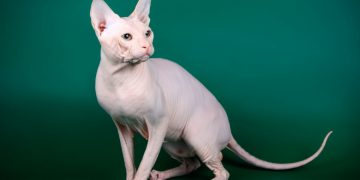The Sphynx is endowed with a particular charm: it reveals a body that appears naked, although covered with a very fine down. In addition to having an original physique, he turns out to be an excellent companion cat. Very attached to its owner, the Sphynx likes to be cuddled and is sociable. At the same time calm, lively and intelligent, it is a pleasant daily companion.
Breed History
Known as the naked cat, the Sphynx first appeared in 1966 in Ontario, Canada. However, we can go back to the time of the Aztecs, in Mexico, to find a trace of this atypical cat by its appearance and its physique. Its appearance, as a race, is therefore quite recent.
In 1966, the Sphynx appeared spontaneously. Doctor Hugo Hernandez brings him back to Europe, to the Netherlands. After having worked on the level of the genetic mutation of the animal, and in particular some crossings with the Devon Rex, he began the presentation of this cat in 1973. Patrick Challain, a French breeder, imported them into French territory in 1983. Since , this breed of cat is successful in France. Moreover, according to the LOOF, the Sphynx is considered to be of French origin.
Physical peculiarities
His body: The body of the Sphynx reveals a fine musculature, with some folds at the level of his hips and on his skull.
His hair: He is not entirely naked as one might think. The Sphynx actually has a very fine down, which gives it an impression of peach skin to the touch.
Its color: No real color, only beginnings.
Its head: It is medium, long rather than wide, and reveals folds at the level of its skull.
His eyes: They are fully open, alert. Their color varies according to the color of the coat.
Its ears: They are very large compared to the size of the head and are wide at their base.
Its tail: It is quite long and strangely resembles a rat’s tail.
Feed
Because of its nudity, the Sphynx must eat more than other cats. Indeed, it has a higher body temperature and burns calories faster. He can benefit from unlimited kibble, which is recommended by several breeders. However, it can also be rationed. It will then be necessary to ensure that it has enough to eat so as not to weaken.
There is also “Special Sphynx” food that better meets its nutritional needs. However, these products are more expensive to buy, but reduce the amount of kibble given continuously.












